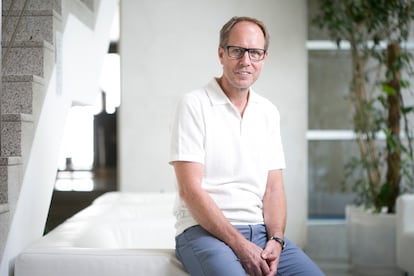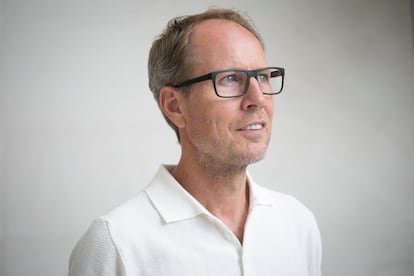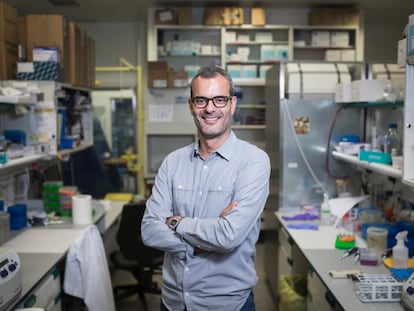Tony Wyss-Coray, neurologist: ‘We can do a blood test and learn what you will die from’
The scientist investigates the rejuvenating potential of young blood, and has created a system that calculates the age of each organ and warns if it is prematurely aging

Molecular biologist Tony Wyss-Coray, 60, has been immersed in the enigmas of blood for more than a decade. The neurology professor at Stanford University studies the rejuvenating potential of certain components of the blood of young individuals. He has shown that transfusions have a revitalizing effect, especially on the brain, and has confirmed this in Alzheimer’s patients, although this research has been put on hold due to lack of funding. In this interview, Wyss-Coray explains his latest findings, such as a blood test that determines the age of each of our organs and calculates the risk of dying prematurely.
Question. You have said that the fountain of eternal youth is within all of us, but that it dries up over time. What do you mean?
Answer. The composition of blood changes dramatically as we age. We can take young blood and put it into an old person and make them younger. That suggests that what is in ourselves when we are young can keep the body young, but that we lose it with age. If you could continually give someone young blood, their body would not age so quickly.
Q. You have said that we age in waves. What does that mean?
A. Aging is not linear. There are proteins characteristic of youth that increase from the moment we are born until we reach midlife; and others associated with aging whose levels begin to rise in the last third of life. We see a big change around age 40. Then there is a stabilization, then another big change at 60, and finally the big peak at 80, which is when most of us die. This entire process is characterized by the type of proteins that circulate in the blood.
Q. Can’t those waves be stopped?
A. No, because we don't know what the switches are that make us change phase. And even more so, we do not know if these molecules are a reflection of the organism's aging, or are responsible for it. We are talking about thousands of different molecules. An experiment would have to be done for each of them, which is complicated.
Q. But it has been seen that young blood rejuvenates organs.
A. There was a study led by Tom Rando [researcher at Stanford University] that showed that young blood rejuvenates muscle stem cells. When you’re old, muscles stop regenerating because those stem cells stop doing their job. This experiment demonstrated in mice that young blood reactivates muscle stem cells. It also has an effect on other tissues, such as hematopoietic cells, which make up the immune system. We saw something similar in the brain. The other interesting observation is that with age there is an increase in inflammation throughout the body, and young blood also seems to reduce inflammation.
Q. Why?
A. We don’t know. I don’t think it’s through stem cells, but rather an active effect of blood proteins. We also know that removing plasma from an older individual is beneficial, because the body probably accumulates toxic factors over time.
Q. You and other groups are testing these effects in Alzheimer’s patients. What has been observed so far?
A. What people have tried is to remove plasma from old people and then give them young plasma. This same procedure, apheresis, is used in cases in which we are not clear what disease the patient has, for example autoimmune diseases, or also chronic fatigue syndrome. That seems to be beneficial.
Q. What results were seen in Alzheimer’s?
A. Grifols did a phase 2-3 trial several years ago. It showed clear benefits for patients. The ones we did with the company I co-founded, Alkahest, were not as compelling due to the small number of patients; but those from Grifols, with a double-blind and controlled trial, showed clear improvement. But no progress has been made.
Q. Why?
A. Because Grifols doesn’t have money. They had a lot of problems during the pandemic and then applied for a lot of cheap loans from the European Union and banks. Interest rates went up and now they have a lot of debt. They have also been accused of poor business practices. They don’t have money to continue with trials. Another major problem is that they couldn’t make money from this. Grifols is dedicated to selling plasma and it is a relatively cheap product. How could they charge five times more for giving it to people with Alzheimer’s?

Q. Even if this were to be transformed into a treatment, you say that it would likely be impossible to carry it out, why?
A. Because benefits have been seen not only in people with Alzheimer’s, but also other diseases. Sarcopenia [muscle loss], heart ailments. Millions of people could be treated with plasma and it would be beneficial. The problem here is that there wouldn’t be enough plasma to treat everyone. There are rich people who pay for plasma transfusions, and they have been doing so long before all this was known.
Q. Are these treatments reliable?
A. No. It probably has some benefit, but there are only anecdotal cases of improvement in general health and also in cognition. In fact, this is how Alkahest was founded. The funds were provided by a wealthy Hong Kong family. The head of the family had Alzheimer’s. He received a transfusion because he also had cancer. His grandson realized that every time his grandfather had a transfusion his memory returned and he could talk to him again. He was the one who provided the funds. [The founder was Chen Din Hwa, a billionaire of Chinese origin, who died in 2012. After seeing the extraordinary effects of the transfusions, his relatives provided the funds to create Alkahest. The company was acquired by Grifols in 2020].
Q. Is there any other way to unblock this situation?
A. Hopefully, but it is very complex. There are tens of thousands of proteins in plasma, and among them there are hundreds of thousands of different variants. We don’t know which ones we need. Here we return to the problem of the natural fountain of youth. It is possible that the rejuvenating proteins we have in our blood are in a different conformation than if we synthesized them in the laboratory. Animal experiments would have to be done for each one, but it is an enormous and very expensive challenge; we are talking about about 10,000 molecules. There are now many companies focused on identifying some of these rejuvenating factors.
Q. Could they be turned into a drug?
A. It’s complicated. In the European Union, the United States, practically in any geographic area, normally a single compound, a certain molecule, is approved. If we need a cocktail of, say, 10 proteins, how do we do it? Do we test each one separately in patient trials? How do we know that those 10 are better than just five? And worse still, nothing is stopping a competitor from stealing your idea, because we are talking about proteins that are in plasma. There are many issues to figure out.
Q. Are you pessimistic?
A. No. I think that despite everything we will see some treatment of this type, perhaps in the next 10 years. Because we can clearly identify factors that are beneficial for something specific. They may not have that beneficial effect on a whole-body level, but they are still useful. And then we know very negative factors that we could neutralize. Perhaps this option is the most viable.
Q. Let’s go back to aging. I am 44 years old, but my brain or my heart may already be 55. That increases my risk of suffering from Alzheimer’s or dying prematurely to a very high level, even more than smoking?
A. That's right. The risk of dying if you have a very old heart is five times greater than smoking. But these are rare cases. Most people have fairly adjusted organs for their age.
Q. How do you know the age of each organ?
A. Some proteins come from specific organs and give us information about their health. The amount of these proteins in your blood may be normal for your age, or characteristics of people younger or older than you. This way we can estimate the approximate age of your organs. It makes me wonder if diseases are nothing more than a reflection of aging. If your heart ages too much, at some point, you will be told you have heart disease. If it is your brain, you will get Alzheimer’s. What’s not clear is why most people seem to show only one organ with this accelerated aging behavior.
Q. Does it also work the other way around, can a younger organ rejuvenate the others?
A. If you have a young brain, you will live longer. If you have a young immune system, too. It is not clear whether it is a rejuvenating effect or simply that an effective immune system protects you from getting sick. It is the eternal question of cause and effect. Is it genetic? How much does lifestyle and diet contribute? We do not know.
Q. The organ that poses the greatest risk of death if it is older than normal is the brain, why?
A. It is not clear. Perhaps because this organ regulates much more in the body than we think. Of course, it controls the production of hormones, with effects throughout the body, but probably also other factors that regulate the functioning of other organs.
Q. One of your latest studies was based on 50,000 patients from the United Kingdom’s Biobank. An already considerable number of cases. What is needed to be able to bring these findings to medicine?
A. We have to study people before and after a specific intervention and see how their organs respond. For this, longitudinal studies must be carried out, that is, multiple samples of many patients, to confirm if this intervention is really effective.
Q. When there is data from many more patients and analysis power thanks perhaps to artificial intelligence, how far can we go?
A. We can probably do a blood test on a middle-aged person and know what they will get sick from and calculate when they will die.
Q. That’s pretty scary.
A. Only if you can’t do anything about it. But that’s always been the case in medicine. We need to know who is most at risk. For example, high cholesterol and heart attacks. Before, there were entire families in which everyone died of heart problems at 50 or 60. Later it was discovered that it was due to certain genetic mutations and studies in this population helped show that controlling cholesterol is good for everyone.
Q. What if the analysis says that what is very old is the brain?
A. That’s worse, because there’s not much to do. Although for the first time there are drugs that seem to have a small positive effect against Alzheimer’s. Now we do clinical trials with patients without knowing the age of their organs and many times the medications do not show effectiveness. But what if we set up one with patients whose brains are older than normal? Maybe we see that these discarded drugs do benefit them. That’s why I think there will soon be trials that are much more focused on people who are at high risk of Alzheimer’s.
Sign up for our weekly newsletter to get more English-language news coverage from EL PAÍS USA Edition
Tu suscripción se está usando en otro dispositivo
¿Quieres añadir otro usuario a tu suscripción?
Si continúas leyendo en este dispositivo, no se podrá leer en el otro.
FlechaTu suscripción se está usando en otro dispositivo y solo puedes acceder a EL PAÍS desde un dispositivo a la vez.
Si quieres compartir tu cuenta, cambia tu suscripción a la modalidad Premium, así podrás añadir otro usuario. Cada uno accederá con su propia cuenta de email, lo que os permitirá personalizar vuestra experiencia en EL PAÍS.
¿Tienes una suscripción de empresa? Accede aquí para contratar más cuentas.
En el caso de no saber quién está usando tu cuenta, te recomendamos cambiar tu contraseña aquí.
Si decides continuar compartiendo tu cuenta, este mensaje se mostrará en tu dispositivo y en el de la otra persona que está usando tu cuenta de forma indefinida, afectando a tu experiencia de lectura. Puedes consultar aquí los términos y condiciones de la suscripción digital.
More information
Archived In
Últimas noticias
NASA discovers Titan doesn’t have an ocean, but a ‘slushy ice layer’ that increases possibility of life
Innocence lost in the forest of the child soldiers: ‘Each leader of the armed group had his girls’
‘Fallout’ or how the world’s largest company turned an anti-capitalist apocalyptic Western into a phenomenon
From inflation to defending migrants: Eileen Higgins and Zohran Mamdani inaugurate the new Democratic resistance against Trump
Most viewed
- ‘El Limones’ and the growing union disguise of Mexican organized crime
- Christian Louboutin: ‘Young people don’t want to be like their parents. And if their parents wear sneakers, they’re going to look for something else’
- The low-cost creative revolution: How technology is making art accessible to everyone
- ‘We are dying’: Cuba sinks into a health crisis amid medicine shortages and misdiagnosis
- Liset Menéndez de la Prida, neuroscientist: ‘It’s not normal to constantly seek pleasure; it’s important to be bored, to be calm’











































